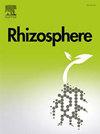Arbuscular mycorrhizal colonization promotes plant growth and regulates biochemical and molecular defense responses against Pythium myriotylum and Meloidogyne incognita in ginger (Zingiber officinale Rosc.)
IF 3.4
3区 生物学
Q1 PLANT SCIENCES
引用次数: 0
Abstract
This study investigated the effects of arbuscular mycorrhizal fungi (AMF) inoculation on growth, nutrient uptake, and defense mechanisms against Pythium myriotylum and Meloidogyne incognita in ginger (Zingiber officinale Rosc.). Structural colonization of AMF was confirmed in inoculated ginger roots, with colonization rates of 90 % and 80 % at two and six months, respectively. AMF significantly enhanced plant height and number of tillers compared to non-inoculated controls. Nutrient uptake was notably higher in AMF-inoculated plants, with increased levels of nitrogen (27.81 g wt plant−1), phosphorus (3.89 g wt plant−1), potassium, calcium, magnesium, and micronutrients. AMF inoculated plants demonstrated 50 % reduction in disease incidence when challenged with P. myriotylum. Similarly, AMF preinoculated ginger plants showed no Meloidogyne incognita (J2s) penetration in the roots, unlike plants treated only with M. incognita (J2s). Additionally, protray experiment was conducted to study the possible correlation between the disease resistance traits of AMF using biochemical and molecular methods. In this study, the enhanced activity of antioxidant enzymes, such as peroxidase, catalase, and β-1,3-glucanase, was observed in AMF-primed plants under pathogen inoculation, particularly with combined infections of P. myriotylum and M. incognita, indicating improved systemic resistance. At the molecular level, AMF priming altered the expression of key defense-related genes. In AMF-treated plants, the NPR1 gene, which regulates systemic acquired resistance, was notably upregulated in roots with P. myriotylum, while TGA and AP2, involved in salicylic acid signaling and stress response, exhibited strong expression in the presence of AMF and M. incognita. In leaves, LOX2, a key enzyme in jasmonic acid biosynthesis, showed the highest expression with M. incognita, whereas AOC, essential for jasmonate signaling, steadily increased in AMF-primed plants with P. myriotylum. These findings indicate that AMF colonization supports nutrient uptake, plant growth, and systemic defense, thereby enhancing resistance to pathogen infections in ginger.
姜丛枝菌根定植促进植物生长,调节姜对霉霉和凶霉的生化和分子防御反应。
本研究研究了接种丛枝菌根真菌(AMF)对生姜生长、营养吸收的影响,并探讨了姜对myriotyum和Meloidogyne incognita的防御机制。结果表明,AMF在接种后2个月和6个月时的定植率分别为90%和80%。与未接种的对照相比,AMF显著提高了植株高度和分蘖数。接种amf的植株的养分吸收量显著增加,氮(27.81 g wt plant - 1)、磷(3.89 g wt plant - 1)、钾、钙、镁和微量营养素的吸收量均有所增加。AMF接种的植物在受到myrityum的攻击时,疾病发病率降低了50%。同样,AMF预接种的生姜植株根系中也没有出现隐性蔓胞杆菌(Meloidogyne incognita, J2s)的渗透,而只接种了隐性蔓胞杆菌(m.a incognita, J2s)。此外,利用生物化学和分子生物学方法,对AMF抗病性状之间可能存在的相关性进行了实验研究。在本研究中,amf引发的植物在病原菌接种下,抗氧化酶(如过氧化物酶、过氧化氢酶和β-1,3-葡聚糖酶)活性增强,特别是在myriotyum和M. incognita联合感染下,表明系统抗性增强。在分子水平上,AMF引发改变了关键防御相关基因的表达。在AMF处理的植物中,调控全身获得性抗性的NPR1基因在myriotyum根中显著上调,而参与水杨酸信号和胁迫反应的TGA和AP2基因在AMF和M. incognita存在下表现出强烈的表达。在叶片中,茉莉酸生物合成的关键酶LOX2在M. incognita中表达量最高,而对茉莉酸信号传导至关重要的AOC在amf启动的myriotylum植株中表达量稳步增加。这些结果表明,AMF定殖支持生姜的营养吸收、植物生长和系统防御,从而增强生姜对病原菌感染的抵抗力。
本文章由计算机程序翻译,如有差异,请以英文原文为准。
求助全文
约1分钟内获得全文
求助全文
来源期刊

Rhizosphere
Agricultural and Biological Sciences-Agronomy and Crop Science
CiteScore
5.70
自引率
8.10%
发文量
155
审稿时长
29 days
期刊介绍:
Rhizosphere aims to advance the frontier of our understanding of plant-soil interactions. Rhizosphere is a multidisciplinary journal that publishes research on the interactions between plant roots, soil organisms, nutrients, and water. Except carbon fixation by photosynthesis, plants obtain all other elements primarily from soil through roots.
We are beginning to understand how communications at the rhizosphere, with soil organisms and other plant species, affect root exudates and nutrient uptake. This rapidly evolving subject utilizes molecular biology and genomic tools, food web or community structure manipulations, high performance liquid chromatography, isotopic analysis, diverse spectroscopic analytics, tomography and other microscopy, complex statistical and modeling tools.
 求助内容:
求助内容: 应助结果提醒方式:
应助结果提醒方式:


